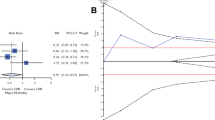Summary.
A prospective, controlled, randomized trial was conducted in 275 patients with symptomatic gall stone disease, whose history, laboratory data or sonographical findings did not suggest common bile duct stones. Of these patients, 137 did not undergo intraoperative fluoroscopic cholangiography (IOC), but in the remaining 138 patients IOC was attempted. In 111 cases (80.4 %) the biliary system was sufficiently visualized. In 3 patients (2.7 %) calculi in the cystic or common bile duct were diagnosed, which would have been overlooked without IOC. IOC was false-positive in one case. One year after the operation the patients were asked to return for a follow-up examination. Three patients in the group without IOC had had symptomatic passage of a stone, and one had a common bile duct stone removed by endoscopic papillotomy. A retained stone was discussed as etiology for a pancreatitis in a fifth patient in this group. No patient sustained long-term sequelae from the retained common bile duct stones. None of the patients in the IOC group had evidence of cholangiolithiasis at follow-up. There was no difference between the study groups concerning the incidence of post-operative complications. The operations with IOC lasted significantly longer (92 ± 31 min vs 77 ± 28 min). According to our data and those published earlier, the additional financial and logistic expenditure associated with routine IOC is not justified. Patients with the preoperative suspicion of a common bile duct stone should have endoscopic bile duct clearance (ERCP and EPT) prior to cholecystectomy.
Zusammenfassung.
275 Patienten mit einem symptomatischen Gallensteinleiden, bei denen aufgrund von anamnestischen Angaben sowie laborchemischen und sonographischen Befunden kein Hinweis auf eine Choledocholithiasis vorlag, wurden in eine prospektive, kontrollierte, randomisierte Studie eingeschlossen. Bei 137 Patienten wurde im Rahmen der Cholecystektomie keine intraoperative Cholangiographie (IOC) durchgeführt, bei den verbleibenden 138 Patienten wurde sie versucht. In 111 Fällen (80,4 %) gelang es, das Gallenwegsystem darzustellen. In 3 Fällen (2,7 %) wurden Steine im Ductus cysticus bzw. im Ductus choledochus nachgewiesen, die ohne IOC verblieben wären. In einem Fall lieferte die IOC ein falsch-positives Ergebnis. Die Patienten wurden ein Jahr nach der Operation einer Nachuntersuchung unterzogen. Drei Patienten, bei denen keine IOC durchgeführt worden war, hatten zwischen Operation und Nachuntersuchungstermin einen symptomatischen Steinabgang. Bei einem weiteren Patienten wurde dies als mögliche Ursache einer Pankreatitis diskutiert. In einem Fall war ein Choledochuskonkrement mittels endoskopischer Papillotomie (EPT) entfernt worden. Keiner der Patienten erlitt durch die Gangkonkremente einen bleibenden Schaden. In der Gruppe der Patienten mit IOC ergab sich in keinem Fall ein Hinweis auf ein übersehenes Choledochuskonkrement. Zwischen beiden Studiengruppen bestand kein Unterschied hinsichtlich der Häufigkeit postoperativer Komplikationen. Die Eingriffe mit IOC dauerten signifikant länger (92 ± 31 vs. 77 ± 28 min). Aufgrund der Ergebnisse dieser Studie und der Daten in der Literatur ist es nicht gerechtfertigt, den zeitlichen, logistischen und materiellen Mehraufwand einer IOC im Rahmen jeder Cholecystektomie in Kauf zu nehmen. Patienten, bei denen sich aufgrund präoperativer Angaben oder Befunde der Verdacht auf eine Cholangiolithiasis ergibt, können vor der Cholecystektomie einer endoskopischen Gallenwegsanierung (ERCP und EPT) zugeführt werden.
Similar content being viewed by others
Author information
Authors and Affiliations
Rights and permissions
About this article
Cite this article
Nies, C., Bauknecht, F., Groth, C. et al. Intraoperative Cholangiographie als Routinemethode? Eine prospektive, kontrollierte, randomisierte Studie. Chirurg 68, 892–897 (1997). https://doi.org/10.1007/s001040050290
Issue Date:
DOI: https://doi.org/10.1007/s001040050290




